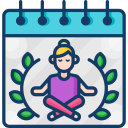Improving Mental Focus through Yoga
Chosen theme: Improving Mental Focus through Yoga. Welcome to a warm, practical journey into breath, movement, and attention. Today we explore how simple, consistent yoga practices sharpen concentration, steady emotions, and help you do your best work. Join in, share your experiences, and subscribe for weekly focus-friendly insights.
Foundations for a Focused Yoga Practice
Slow diaphragmatic breathing steadies the nervous system and gives your mind a clear point to rest on. Count gentle inhales and longer exhales, noticing how attention wanders, and kindly escort it back to the breath without judgment, again and again.
How Yoga Shapes the Attentive Brain
Returning attention to a chosen object trains the brain’s attention networks through repetition. Each redirection is a rep, strengthening selective attention, reducing mind-wandering, and building metacognitive awareness so you notice drift faster and recover focus with less friction.


How Yoga Shapes the Attentive Brain
Breath-led movement stimulates parasympathetic tone and softens stress reactivity. When physiological arousal is balanced, working memory and decision-making improve. Calm body, clear mind: the link is practical, not mystical, and it shows up in everyday concentration tasks.
A 10-Minute Daily Sequence for Busy Minds
Sit tall, close your eyes softly, and practice four counts in, six counts out. Relax the jaw and widen the back of the breath. Name one intention for focus today, like sustained single-tasking, and imagine completing one task with calm precision.

Trataka: Candle-Gaze Concentration
Light a candle at eye level and gaze softly at the flame without blinking until tears arise, then close your eyes and visualize the afterimage. This trains visual steadiness, reduces restless scanning, and teaches the mind to anchor on a single stimulus.
Box Breathing for Resetting Attention
Inhale, hold, exhale, hold—each for four counts. The clear structure makes the mind feel safe and contained. After a few rounds, return to your task and notice improved precision. Share how many cycles help you most so others can learn.
One-Task Windows with Gentle Boundaries
Choose one task and a time window, silence notifications, and put your phone out of reach. Begin with three mindful breaths before working. When impulses flare, note them kindly and recommit to the chosen task. Celebrate completion with one deep, satisfying exhale.
A Real-Life Story: From Scatter to Steady
A reader named Maya tracked her focus and found she switched tasks every seven minutes. She committed to five minutes of breath before work and one steady-gaze pose. The early days felt awkward, but the ritual created a small pocket of clarity.
A Real-Life Story: From Scatter to Steady
By week three, Maya noticed she could outline complex emails without rereading sentences repeatedly. She credited box breathing before drafting and a consistent Mountain Pose break at midday. She shared her routine, inviting coworkers to try the same reset.
A Real-Life Story: From Scatter to Steady
Six weeks in, Maya’s concentration held through meetings and deep work blocks. She logged fewer browser tabs, steadier breath during stress, and kinder self-talk after slipups. She now mentors new readers—comment if you want her simple, printable checklist.
Environment, Tools, and Rituals for Clarity
Design a Distraction-Light Practice Corner
Clear a small space with a mat, cushion, and soft natural light. Keep only essentials visible to reduce cognitive load. Add a plant or simple artwork as a steady gaze point. The calm order cues your mind to settle and attend.
Timers, Journals, and Gentle Prompts
Use a quiet timer for practice intervals and keep a short focus journal. After each session, log one distraction you met and how you returned. Over time, patterns emerge, and you can refine your anchors and intentions with thoughtful precision.
Digital Hygiene that Protects Attention
Batch notifications, schedule check-ins, and place the phone outside arm’s reach during practice. Create app groups for focus and limit novelty scrolling beforehand. Tell us your best digital boundary in the comments to help others protect their mental clarity.
Deepening Practice: From Dharana to Dhyana
Choose one anchor—breath, mantra, or flame—and keep returning without force. Let effort be steady, not strained. You are training patience as much as attention. Short, consistent sessions work best, inching the mind toward reliable stillness and clear perception.
With practice, attention rests more easily, like a cup placed on a stable table. Striving fades, awareness widens, and mental chatter quiets. This is not mystical escapism—it is trained presence that supports creative problem-solving and humane decision-making.
Guided body scans and breath awareness in Yoga Nidra can restore mental energy when fatigue blurs focus. Even brief sessions help reset. Try a midday practice, then note changes in clarity. Share your favorite cues so our community can experiment.

